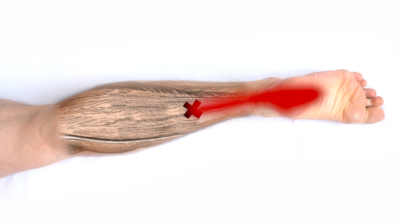Pain in polyneuropathy has two main causes:
- Painful nerves here targeted training can help of the nervous system. In particular, signal processing in the brain plays a role in nerve pain. This can be trained through certain types of training. A good supply of vitamins and nutrients can support the nerves and at least slow down deterioration. Proper nutrition can help relieve some forms of polyneuropathy or at least prevent it from getting worse.
- Pain due to overloaded muscles: special massages and stretches as well as targeted training can help and often significantly improve the pain. As polyneuropathy reduces muscle strength and worsens coordination, muscle overuse is more common and can cause pain.
What helps against the pain in polyneuropathy - summed up
What can help with pain in polyneuropathy:
1. training of the nervous system
2. massage and stretching your muscles
3. good supply of nutrients (vitamins B and D and omega-3 fatty acids).
4. physiotherapy with vibration training and electrotherapy
5. painkillers
For self-help, training of the nervous system and massage or stretching of muscles are the easiest to implement.
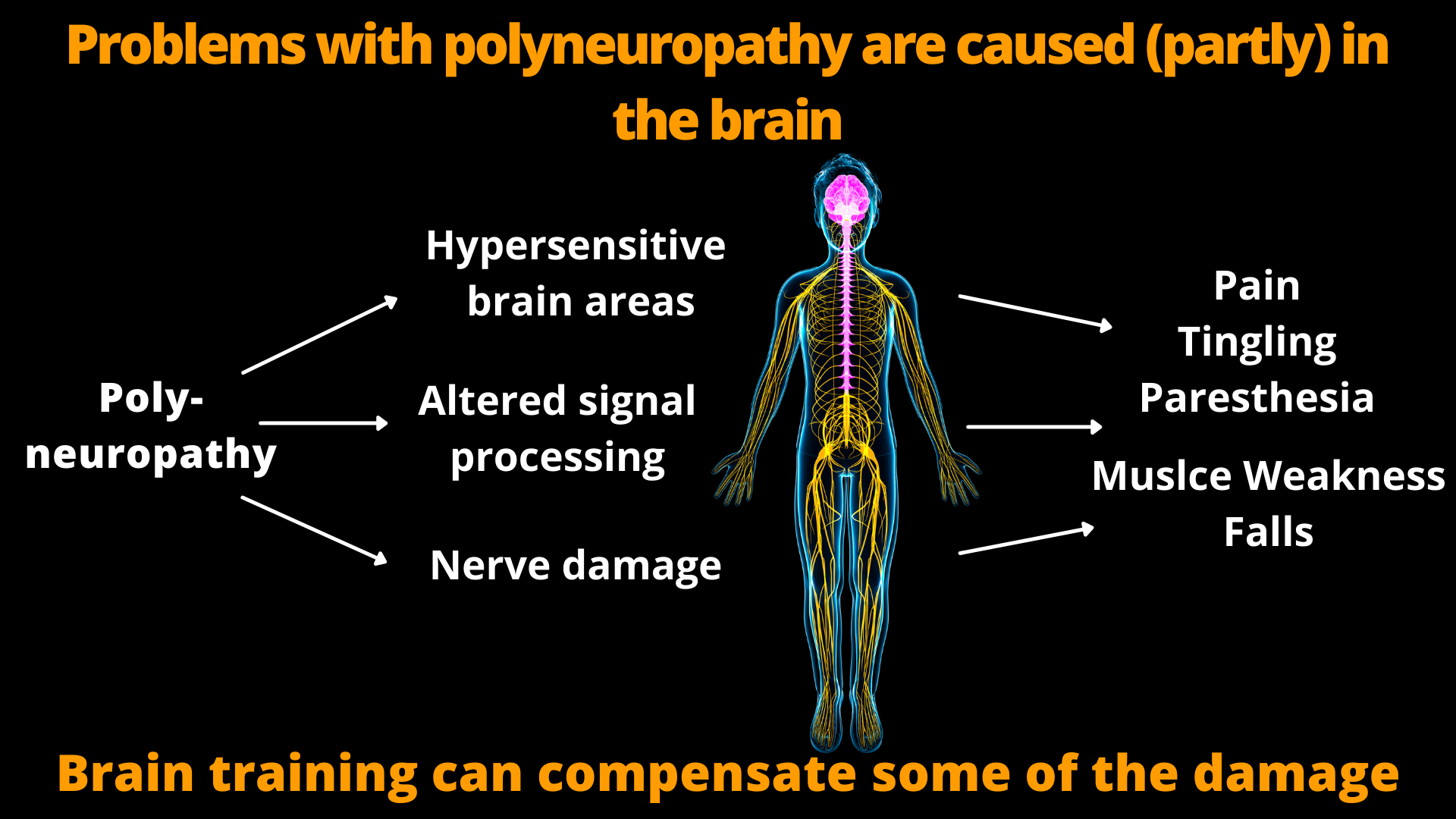
Why does polyneuropathy hurt?
In order to be able to do something about the pain, one must first know how the pain arises, or what its cause is. Because only if you understand the causes exactly you can also find remedies.
The idea that the nerves cause pain because they are damaged is overly simplistic and one of the reasons why it is often assumed that there is no help.
The main causes of pain in polyneuropathy
1. painful nerves (neuropathic pain) and altered signal processing.
Polyneuropathy does not cause pain in all patients. It can happen that two people are given the exact same diagnosis, but one has very severe pain, while the other doesn't notice anything at all. Why is that?
Pain is caused by the way signals are processed in the nervous system. In polyneuropathy, certain areas of the brain may be hypersensitive and therefore report pain even though there is no "real" problem (for a scientific artilce on this, see: Fischer & Waxman (2010)). So the important thing is what happens in the brain, not just what happens in the body part where you feel the pain.
Therefore, it can help against the pain if you train the nervous system specifically. In particular, the training of the perception of the body and coordination are helpful for this. You can find exercises and more details on this below.
2. overloaded muscles
In addition, pain may occur not only due to nerve damage, but also due to overuse of muscles.
With polyneuropathy, muscle strength decreases and movement patterns change. Therefore, overload often occurs, but you do not notice it at first because have a reduced perception of your own body due to the disease.
If this is the case, the pain can often be reduced very well by massage and stretching. To do this, it is very important to know exactly where the pain is. For example, pain of the back of the foot requires massage and stretching in completely different places than pain on the sole of the foot. However, if you know these spots, the treatment can be quite simple.

Is there really nothing that can help you except painkillers?
When dealing with polyneuropathy, you usually hear that there is no cure and nothing that helps with the pain except painkillers. However, my personal experience as a therapist is that actually there are methods that can help. Also, some scientific papers show that there are ways to relieve pain.
Here I would like to introduce you to two methods that are surprisingly simple and can be easily applied at home. It is best to try them directly while reading this article. At the end of the article, I go into more detail about other causes of pain and treatment options.
I am a sports scientist and sports therapist and therefore work according to an approach that can be summarized as follows: Strengthen what still works instead of fixing what is broken. In terms of polyneuropathy pain, this means training the nervous system and keeping the muscles in good condition. This can often significantly reduce pain. So what I present is a guide to self-help and not a substitute for medical treatment.
These methods cannot heal nerves - but they can still reduce pain in a lot of cases. So the polyneuropathy persists, but the pain may still subside.
Training the body awareness and muscles helps against pain - even if the nerves are damaged!
The methods for self-help against pain
In the first half of this article, I would like to introduce you to training for the nervous system. This improves body awareness and coordination, and over time, with consistent practice, reduces pain.
In the second half of the article, I explain how to massage and stretch the muscles in oreder to reduce pain - sometimes immediately.
1. training of the nervous system
As a sports therapist, you constantly apply training methods to solve physical problems. This may mean strengthening one part of the body to compensate for damage elsewhere. For example, those who have a herniated disc can often get rid of the pain by strengthening their back muscles. This does not cure the herniated disc, because the disc itself is not exercised. However, the pain will still get better as the muscles get stronger and the spine becomes more stable as a result. Strengths in one place can therefore compensate for weaknesses elsewhere. This principle can also work in polyneuropathy to improve pain.
This is because when polyneuropathy damages the nerves in the feet or hands, that damage cannot be reversed by training. However, it is possible to train how the nervous system deals with it.
The nervous system is the fastest and best trainable organ we have. And it can be trained almost without physical strain. So you can do exercises for the nervous system even if you are very weak. Such exercises have been successfully used in sports for a long time. However, the knowledge about them also being helpful in polyneuropathy is relatively new.
The fact that it is possible to train the nervous system and thereby reduce pain was discovered almost by accident. In search of a way to help patients with polyneuropathy walk better and more safely, scientists trained balance with patients. (I luckily happened to be working in a group of such scientists back then) So they had people practice standing stable in wobbly positions. Such as on a foam cushion. While doing this, the nervous system must constantly sense exactly what position you are in, how the surface feels and how much muscle tension is present. In addition, all this information must be interpreted correctly and a reaction to it must be made. So this is hard work for the nervous system.
As expected, this type of exercise significantly improved the patients' balance. Surprisingly, however, the trained patients also had less pain.
However, upon further investigation, it was found that the nerves of the patients who exercised were just as damaged as those of the patients who did not exercise. But they felt less pain anyway. In other words, the improvement in pain did not come from healing of the nerves. Instead, the body seemed to learn to compensate for the nerve damage through training.
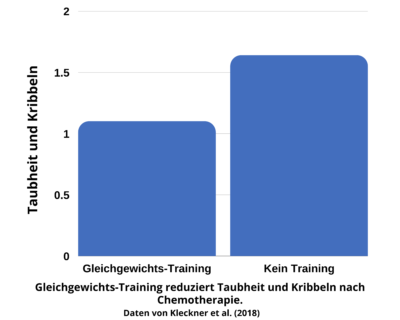
How to train the nervous system and body awareness
Train your body awareness
The best tool we have for this is balance training. This improves your ability to perceive and control the body, i.e. body awareness. So your body learns to process stimuli from the nerves better. And for some patients, this improves pain.
It has long been known that body awareness can be trained. Athletes have been training this way for a long time and protect themselves from injuries with it, while seniors improve their gait and fall less often after training this way.
What is new is that this training can also reduce pain in polyneuropathy.
It is important to understand that such training does not make all pain disappear, because the damage in the nerves cannot be cured by training. However, there is often an improvement in symptoms. You have to be patient, though, because the improvement comes gradually over months.
There are also people whos' pain does not improve with training, the reason which is not yet known. But even if this is the case for you, training your balance still gives you better coordination, safer walking and better mobility.
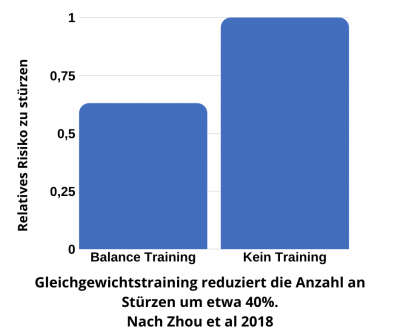
Pain is felt in the brain
I was involved in the data analysis of a study on this back in 2012/13 and remember how surprised we as scientists were by the reduction in pain and how no one had an explanation for it.
The only thing that was clear was that it was a process in the brain.
My personal hypothesis is this:
The nervous system is a sommunication system and can be compared to a radio. There is a sender (the nerves in the feet or hands) and a receiver (the brain). If the signal is disturbed, instead of a clear sound, noise (pain) arrives at the receiver. This is no different with the nervous system than with the radio. Noise on the radio corresponds to the pain or discomfort of polyneuropathy.
If you receive noise instead of a clear signal on the radio, you tend to turn up the volume to still be able to understand what is being said. However, this also makes the unwanted noise louder.
The brain is also able to make the "receiver" more sensitively. The brain areas that receive the signals from hands or feet then become more sensitive. You could say the brain listens more closely. However, this also increases the "noise". This contributes to all of the well-known polyneuropathy sensations - from tingling to pain.
You can read about this connection here:
So you see: The pain in polyneuropathy does not only originate in the hands or feet, but also partly in the brain.
This gives us a starting point for training and hope for help with the pain. Because the brain is the most trainable organ we have.
Pain when your are walking
If your pain is particularly severe when walking, it may be especially helpful to do balance exercises. This will improve your coordination and make you able to perform the movements more gently.
You should also try massaging and stretching the affected regions as described below. In fact, pain while walking is often caused by overworked muscles. If the muscles are relaxed, this often relieves the pain as well - even though the polyneuropathy persists. If you do not have pain when you first take steps and it does not occur until you have walked for a while, it is very likely that the pain is at least partially caused by overworked muscles and not by the polyneuropathy.
In addition, if you have pain exclusively when walking and do not feel pain at rest, you should pay attention to wearing the right shoes. Because if you can no longer feel your feet so well due to polyneuropathy, you often don't notice exactly when shoes are too tight or don't fit properly. Try different shoes and pay attention to whether the pain is less severe with a particular model. Unfortunately, there is not "the" shoe for every polyneuropathy patient. However, it tends to be helpful to wear sturdy shoes that provide enough stability to prevent tripping or twisting your ankle. At the same time, however, the shoes should have a relatively soft sole, so that the pressure can be well distributed.
So now you probably want to know some exercises. I will now present an exercise sequence for you to try out immediately.
The exercises are not physically demanding, because as I said, the nervous system should to be trained, not the muscles.
If you want to know more exercises I recommend the Pain Relief Set.
In it you will find detailed exercise instructions with 32 different exercises. The set also includes the book "How to treat your own foot pain", which teaches you how to massage and stretch your feet and lower legs in order to relief pain.
Now I'm going to show you a selection of exercises to try.
Start with the first and easiest exercise and slowly work your way up to the harder variations. If you have trouble keeping your balance during an exercise but can just about manage it, this is the right difficulty level for you. Practice until you find it easier and then choose the next more difficult exercise.
The exercises are selected to provide sufficient difficulty so that there are exercises that are hard enough for everyone, from very weak patients to the very powerful sporty people. Therefore, do not expect too much from yourself. Some of the exercises are probably to hard to do without practice.
Be patient, the exercises have a real effect only if you do them for a few minutes every day for several weeks or months.
Safety first.
In order to lower the risk of falling while you practice, you should always practice in a safe way. So while you do the exercises, stand between a table and a sturdy chair. If you lose your balance just sit down or hold on to the table.
The exercises
First, stand up normally. If this is easy for you, close your eyes. Closing your eyes causes you to rely on information from the nerves in your body instead of your vision. So it is literally training for your body awareness.
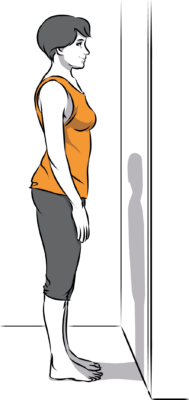
If you want to make the exercise a little bit more difficult, now place one foot forward so that the ball of one foot and the heel of the other foot touch. However, offset the feet slightly to the side of each other.
Should this also be possible without any problems, close your eyes.
The next most difficult variation is to put the feet directly in front of each other, so no longer offset them sideways. You can also try this with your eyes closed.
If you can't do this exercise, that's perfectly fine. It is quite demanding and not easy, even for people without polyneuropathy.
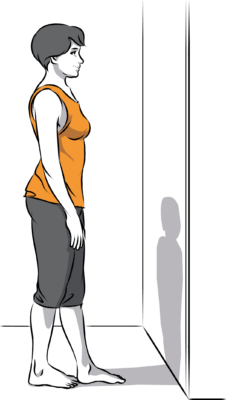
If you haven't wobbled intensely during the last exercise, now stand on one leg.
To make it harder, again close your eyes again.

As the last and most difficult exercise, you can stand on your toes on one leg. If you can do even this with your eyes closed, your balance is better than that of most healthy recreational athletes.
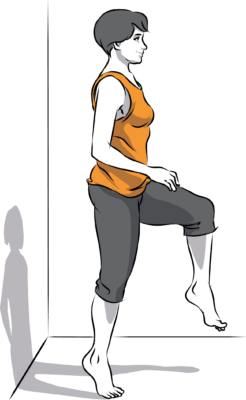
With this workout, you will not only improve your body awareness and hopefully your pain, but you will also protect yourself from falls. After all, the better your balance, the less likely you are to fall and injure yourself.
The exercises shown here are of course only a small selection. There are also numerous other exercises for safe walking and fine motor skills of the hands.
To offer a comprehensive package for training at home I have developed the Pain Relief Set. In it you will find detailed exercise instructions with numerous other exercises for body awareness and against muscle pain. You can find the Pain Relief Set under this link: Pain Relief Set
You can also find more exercises to try here: Exercises for polyneuropathy
In polyneuropathy, the muscles also suffer - and cause pain
2. treating the muscles
To manage the pain of polyneuropathy there is a second approach: treating the muscles with massage and stretching. I have already had several patients who were completely pain-free after such treatment. Even more often, however, the pain gets better, but does not disappear completely.
For example, one of my patients had severe pain all over her feet, from the tips of her toes to her Achilles tendon. After a few treatments, the pain on most of her feet disappeared, only her toes continued to hurt. Another patient with polyneuropathy had severe pain in the lower leg. After only one treatment of the calf muscles, his pain disappeared completely.
Not only the nerves, the muscles also suffer in polyneuropathy
But how can that be the case? Polyneuropathy is a disease of the nerves, not of the muscles!
This is because polyneuropathy reduces muscle strength and changes movement patterns. In addition, because of the limited sensation, you often no longer feel what exactly is going on in your muscles. Therefore, the muscles are often already overloaded by regular everyday life. And muscles can hurt, too. If you can not walk normally and have less strength due to polyneuropathy, then that is problematic for your muscles. Because of the overuse, they tend to tense up or cramp, which can cause incredible pain. Whether the pain then comes from the muscles, or from the diseased nerves is indistinguishable.
In medical terms, such aching muscles are called myofascial pain syndrome and it is by far the most common cause of musculoskeletal pain. Unfortunately, however, it is very very often overlooked, because once the problem has been labeled "polyneuropathy," other causes of pain are no longer considered.
However, the treatment is surprisingly simple and you can do it yourself if you know a few basics about it. In the Pain Relief Set you will find my book "How to treat your own foot pain" with detailed but easy to understand instructions for self-treatment.
Trigger points - mini cramps that cause pain
The most important thing to know to help yourself against the pain is that not always the entire muscles cramp, but usually only small parts of only a few muscle fibers. These are often as small as a marble, but cause great pain in an entire body part. They are therefore called trigger points ( meaning that they are the triggers of pain). If you release the trigger points through massage and stretching, the pain also disappears - often immediately.
Find the right spots
The only complicated part is finding the right trigger point. Often this is in a completely different place than where the pain is felt. Trigger points in the lower leg, for example, can often trigger pain in the bottom of the foot. Each trigger point causes pain in a typical location. These repeat themselves from person to person. Therefore, if you know exactly where the pain is, it is fairly easy to determine where the associated trigger point is located.
You can find a list of all relevant trigger points in my book "How to treat your own foot pain", which is included in the Pain Relief Set.
On the following illustrations you will find examples of important trigger points and their patterns of referred pain. You can search for them on your own legs in the places marked with crosses. If you find spots there that are more painful than the surrounding area when you apply a little pressure, you have found a trigger point. Then search the area with your fingers a little more carefully and look for the most painful spot. This area should get the most attention during the massage. To do the massage, follow the instructions below and afterwards stretch the muscle you massaged.
Stretching and massage for pain in the calf in polyneuropathy
Trigger points in the gastrocnemius muscle in your calf can cause pain all over the back of the lower leg and in the sole of the foot.
To reduce the pain, massage the area marked with a cross. (For massage instructions, see "How to Massage a Trigger Point" at the bottom of this article.) After the massage you should stretch the muscle.
Stretching for calf pain in polyneuropathy works like this:
Stand in front of a chair and place one leg on the seat. Pull the toes up and straighten the knee. Now lean forward with your upper body.
If you have trouble keeping your balance, you can also sit on a chair, extend your leg, pull your toes up and lean forward far enough to create a stretching sensation in your calf.
Pain of the calf in polyneuropathy
Calf pain can also be reduced quite often with polyneuropathy by massage and stretching. The pain in polyneuropathy usually occurs first in the tips of the toes or fingers. If the pain occurs somewhere else, it is relatively likely that the cause of the pain is muscle overuse. This muscle overload occurs as a result of polyneuropathy because the way you move changes and you become less efficient when moving. Therefore, if the muscles are treated, the pain can also become less.
I have had several patients with polyneuropathy who had pain in the calf and became completely pain free after treatment of the muscles. Of course, this is not the case for everyone, but the massage and stretching are worth a try.
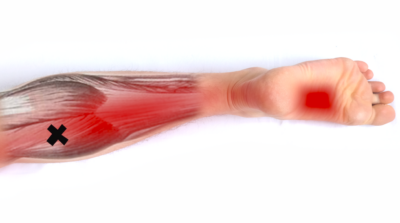
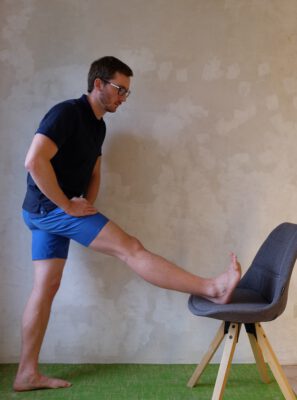
Stretching and massage for pain of the toes in polyneuropathy
The flexors of the big toe can cause pain in the big toe. However, the long toe flexor (flexor hallucis longus muscle) is located far away from the toe on the back of the lower leg. Therefore, it is often not recognized as a cause of pain in the big toe.
The short flexor of the big toe (flexor hallucis brevis muscle) can also cause big toe pain. It is located behind the ball of the foot in the sole of the foot.
To stretch the toe flexors, the front of the foot is placed on a chair in such a way that the heel can be pressed down freely to create some pretension. Then the hands are used to pull the big toe upwards. You will feel a stretch in the lowest part of the lower leg or on the sole of the foot.
Pain of toes and feet in polyneuropathy
The tips of the toes are usually the first part of the body that is affected by polyneuropathy and then the symptoms later spread further to the feet. This is because the nerves that supply the toes are the longest nerves in the entire body. They must conduct signals all the way from the spinal cord or brain to the tips of the toes. In polyneuropathy, many small damages accumulate in the nerves on this long distance and impair the signal conduction. Put more simply, the pain occurs first in the toes because the nerves that connect them to the brain offer the greatest surface for the disease to damage them.
However, muscle spasms in the muscles that move the toes often play a role in the pain, too Often the pain becomes less intense if you massage these muscles.
It is best to simply try stretching and massage as described here to see if it can improve your pain.
By the way, sometimes it can help against the pain to cool the feet a little. To do this, for example, you can fill a water bottle with cold water and put your feet on it.
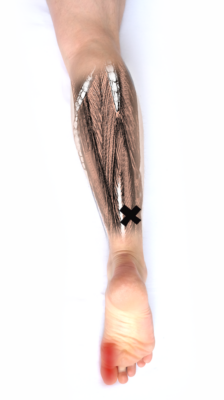
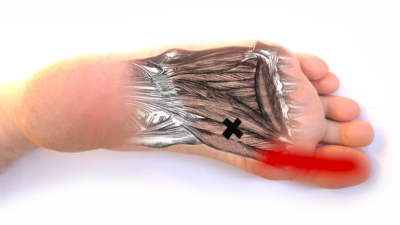
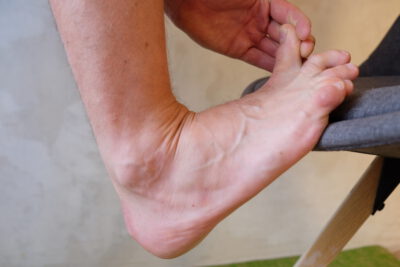
Pain of the heel in polyneuropathy
You also have a relatively good chance of getting better if the pain is on the heel. In these cases, it is relatively likely that muscle cramps and trigger points are contributing to the pain.
A muscle on the sole of the foot, the quadratus plantae, plays an important role in this. To massage it, simply place a tennis ball or any small hard ball under the sole of your foot, press down on it with your foot and move it back and forth to massage the trigger points in the muscle. Stretching this muscle is difficult, so I recommend only stretching it.
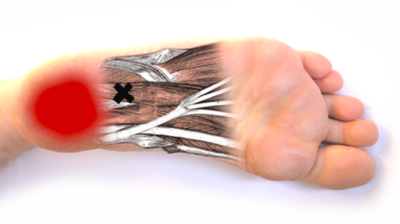
In polyneuropathy, heel pain can also be triggered by muscles in the lower leg
Heel pain can also be triggered by trigger points in a muscle in the lower leg: the soleus muscle. This muscle tends to be overworked also in healthy people. In polyneuropathy, of course, this tendency is even more pronounced and muscle stiffness of the soleus is therefore very common.
If you massage and stretch the trigger points in the soleus, pain in the heel and also the Achilles tendon often get better - although the polyneuropathy persists.
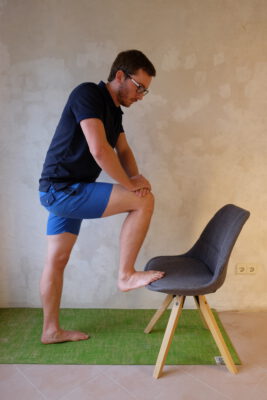
After you have massaged the muscles you should stretch them to achieve a more lasting effect. The muscles in the lower leg are particularly easy to stretch (See photo). It is especially important to hold the stretch for long enough. If you stretch for only a few seconds, that will hardly have any positive effect. It is best to hold the stretch for at least one minute.
How to massage a trigger point
Once you have found the trigger point, the treatment is very very simple.
You use your fingers to find the spot that is most painful. Then, while applying very light pressure, move the finger up or down two to three centimeters. That is our starting position. Then press harder into the muscle and move the finger over the painful point until the pain subsides on the other side. You then move the fingers back to the starting position with very light pressure and repeat the same process about 20 times. Then pause the massage for at least an hour to avoid overstimulating the trigger point.
Firm pressure should be applied so that a distinct pain is felt. However, this pain should only be so strong that it just feels comfortable. You might call this feel-good pain because it is a type of feeling in between comfortable pressure and actual pain.. If you press so hard that an intense pain arises, the body reacts with a defensive tension. This tends to make the cramping worse instead of better. However, if you press too weakly, so that you do not feel any pain at all, the massage will not have any effect. It's best to try and massage in a way that just feels good.
By the way, you can get a good clue from your fingernails. If you press so hard that your fingernails just start to turn white, you have found the right pressure for most trigger points.
Not all types of foot pain are the same
Most people who have pain due to polyneuropathy say the pain in "in the feet." However, if you want to treat the pain effectively it is important to know where exactly on the feet the pain is. For example, pain in the heel requires different treatment than pain in the toes.
My personal experience is that the chances of improving the pain are better if the pain is not felt in the toes. In most cases, the pain starts at the toes, because the nerves that supply them are the most susceptible to polyneuropathy (due to their length). If the top of the foot, calf or heel is painful, then massage and stretching the muscles can often improve the pain significantly.
Pain in the knee and legs
Pain in polyneuropathy usually occurs first in the toes and feet or in the hands. If one has pain exclusively in the knees or thighs, the cause is usually not polyneuropathy. Also, if, for example, the knee and toes hurt, but the area in between does not, it is quite likely that the knee pain is not directly caused by the polyneuropathy, although that may be the case for the toe pain.
In such cases, you should have the knees or thighs examined again. Relatively often, this pain can be treated easily.
The pain does not always disapear immediately
Most of the times a trigger point and thus the pain do not disappear completely during the first treatment. Therefore, you should massage it again and again. However, give your body some time to recover between massages. For example, do 20 massage strokes and then leave the area alone for at least an hour. It is often the case that pain becomes less immediately after treatment. This is an excellent sign! Because now you know what to do to reduce the pain. Often the pain comes back later, however. If this is the case, simply repeat the treatment as often as necessary. It might also help to massage other muscles in the same part of your body.
After the massage you should stretch!
After you massage a muscle, it should be stretched. This is because the trigger point causes the muscles to shorten. By stretching, you pull the shortened muscle fibers apart and bring them to normal length. In addition, the basic tension of the muscles, the muscle tone, decreases due to the stretching. This allows the area you just massaged to relax better. Therefore, you can find the corresponding stretching exercises for the individual muscles directly next to the images of the trigger points.
Stretch for long enough
It is important to do the stretch long enough. People tend to hold the stretch for only a few seconds, as is common in popular sports. However, to achieve a lasting effect in the muscles, the tension should be held for a longer time. The ideal duration would be two minutes. To do this, try to create a stretching tension that you can maintain easily. Stretching does not have to hurt. Go into the stretch until you feel a stretch that is just comfortable and hold this position for 2 minutes. This is by far more effective than holding a painful stretch for a few seconds.
You will find further instructions in the Pain Relief Set
So you can see that there are definitely methods to help yourself against the pain in polyneuropathy. Detailed instructions can be found in the Pain Relief Set. In it you will receive the guide for balance training "Exercise for polyneuropathy" and the book "How to treat your own foot pain", so you get everything you need to start getting rid of your pain.
Ensuring good blood circulation is also important
Apart from these two methods, there are other ways to help yourself against the pain.
It is generally important to ensure good blood circulation. Because if blood circulation is poor, the nerves also suffer and the pain gets worse. To do this, it is important to get plenty of exercise and ensure a good supply of certain nutrients. Omega-3 fatty acids, for example, are helpful here. Those who consume them ensure healthy blood vessels and, accordingly, good blood circulation.
However, omega-3 fatty acids also seem to have a positive effect directly on the nerves. In one study, patients were given additional omega-3 fatty acids during chemotherapy with taxanes. They were then less likely to develop polyneuropathy (Esfahani et al.) 2017). In patients suffering from polyneuropathy due to diabetes, partial regeneration of nerves was observed when they took omega-3 fatty acids as a dietary supplement for one year (Menon et al. 2021).
Whether omega-3 fatty acids are helpful in other forms of polyneuropathy has not yet been determined, however. However, there are also hardly any negative side effects to be expected, so you can try it out for yourself. Only during chemotherapy, you should talk to your doctor before taking additional supplements.
By the way, the omega-3 fatty acids must come from fish or algea oil. Unfortunately, omega-3 fatty acids from plants such as olives have no beneficial effect on polyneuropathy. However, fish oil capsules are available in any drugstore for quite little money.
Ensure a sufficient supply of vitamins
In addition, you should always take enough vitamins. If you suffer from vitamin deficiency, this can worsen polyneuropathy and therefore pain. This is particularly the case with vitamin D and B vitamins. Deficiency of these vitamins alone can cause polyneuropathy. For those who suffer from diabetes for example, their risk for polyneuropathy is significantly increased if they are deficient in vitamin D. If you have polyneuropathy from another cause, it is often made worse by a vitamin deficiency. Therefore, it is important to always have enough of these nutrients in your body.
However, I do not recommend to consume large amounts of vitamins, so more than what you naturally need. Once the need for vitamins is covered, it is not helpful to consume more. Therefore, it is useful to measure the vitamins in your blood. It is best to talk to your doctor about this and have the vitamin concentrations in your blood determined. If you want to take vitamins without consulting a doctor first, follow the manufacturer's instructions printed on the packaging to avoid overdosing. Taking too much vitamins can be quite harmful, especially in the case of vitamin D.
For more detailed information on nutrition in polyneuropathy, see the following article: Nutrition in polyneuropathy

A dietary supplement that can also help is alpha lipoic acid. At least in diabetic polyneuropathy, it seems to relieve pain. However, the effect is greater when given intravenously than when taken as pills.
Again, talk to your doctor first before taking alpha lipoic acid. This is especially true if you are going through chemotherapy, because alpha lipoic acid may interfere with its effects.
Does electrotherapy help?
In addition, electrotherapy methods seem to help some patients. According to scientific studies, the so-called high tone therapy is supposed to alleviate the symptoms of DIABETIC polyneuropathy. However, I am not aware of any studies on other forms of polyneuropathy. However, my experience with my own patients is that noticeable improvement is relatively rare in these other forms. Most patients report that the symptoms of polyneuropathy did not improve after high tone therapy. Some, on the other hand, note a significant improvement. The reason for this is not yet clear.
Another method of electrotherapy used for polyneuropathy is TENS (transcutaneous electrical nerve stimulation). In this method, electrodes are attached to the skin through which electricity is conducted into the body. This can actually reduce some of the pain associated with polyneuropathy. However, the effect disappears after a short time. So after a few hours you feel the same pain as before such treatment.
Vibration exercise
Besides the training methods for balance and treatment of muscles that I mentioned, training on a vibration plate can also be useful.
To do this, you stand on a plate that vibrates. The vibration is a strong stimulus for the nerves. Some people believe that this may stimulate regenerative processes leading to improvement of polyneuropathy.
At least for polyneuropathy due to chemotherapy, there are also two studies on this. In those studies, patients who received chemotherapy and therefore suffered from polyneuropathy did vibration exercise. If the vibration training was performed, symptoms improved more rapidly after the end of chemotherapy.
Whether vibration training is also helpful in other forms of polyneuropathy has not yet been scientifically clarified, to my knowledge. However, if you have a vibration plate available, for example at physio therapy or at a gym, it is worth trying it for yourself.
Doing vibration training correctly for polyneuropathy
As with all forms of exercise, vibration training must be done correctly to get the best results and not overload yourself.
Most importantly, do not train for too long. This is important for two reasons:
- The nerves tire very quickly with a strong stimulus and become, in a sense, unresponsive to the vibration.
- If you are not used to the training, it is very easy to get overloaded and painful.
You should therefore only exercise for 30-60 seconds at a time before taking a break of the same duration. With some practice, you can easily repeat this 5 times. At the very beginning of vibration training, however, you should only stand on the vibration plate for 1 minute.
Overview of means against pain of the legs in polyneuropathy
As you have seen, different types of pain also require different treatment methods. To make it all clearer, I have summarized the most promising things you can do against pain in specific parts of your body in the following table. If you are not a medical professional, the simplest and most useful way to distinguish between different types of pain is the location where you feel the pain. I have therefore summarized all the probable painful areas in the legs and the appropriate things to do about the pan in the following table.
So in the table you can see which options are most promising to treat pain in which location. To make the table, I assumed that the pain occurs only or mainly at the named location. However, the data in the table are not correct in every individual case. If doctors and therapists recommend other methods to you, you should generally do as they say.
| Painful spot | Measures |
| Toes | Balance training, stretching and massage of toe flexors and toe extensors in foot and back of lower leg, vibration training. Have vitamin levels determined. Check with physician for omega-3 fatty acids and alpha lipoic acid. |
| Ball of foot, arch of foot | Balance training, stretching and massage of the muscles of the sole of the foot and the back of the lower leg, vibration training. Have vitamin levels determined. Check with physician for omega-3 fatty acids and alpha lipoic acid. |
| Heel and Achilles tendon | Balance training, massage of the muscles in the arch of the foot. Stretching and strengthening of the calf muscles (Mm. Soleus and Tibialis Posterior). Strengthening exercises can be found here: Sports and polyneuropathy Have vitamin levels determined. Check with physician for omega-3 fatty acids and alpha lipoic acid. |
| Arch and shin | Massage and stretch the muscles of the shin. Strengthen muscles that raise the foot (m. tibialis anterior, m. extensor hallucis, m. extensor digitorum) You can find exercises for this here: Sports and polyneuropathy |
| Calf | Massage and stretching of the calf. Strengthening the calf muscles. You can find exercises here: Sport for polyneuropathy |
| Knee and thigh | See doctor and have knee joint examined. Massage and stretch the knee extensors. Strengthening of the thigh muscles |
Self-help with the Pain Relief Set
If you found this article helpful I recommend the "Pain Relief Set".
In it you will find:
- The Exercise Guide "Exercise for Polyneuropathy. This book contains a system of exercises to train your nervous system at all levels of difficulty - from very easy to very hard.
- The book "How to treat your own foot pain". With this book you can learn a easy and very practical way to reduce your own foot pain - often immediately.

